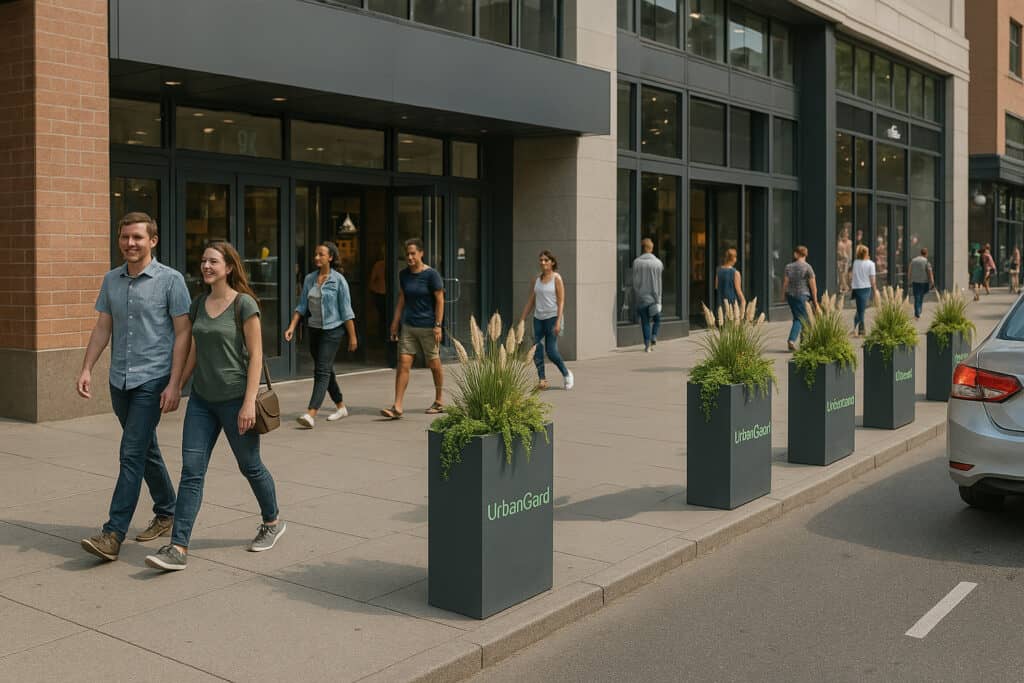Crash-Rated Bollards: Essential Protection for Safer Public Spaces
Quick Summary
Crash-rated bollards are advanced security barriers designed to protect pedestrians, infrastructure, and public spaces from vehicle impacts. Engineered to withstand high-speed collisions through rigorous testing, they are crucial for safeguarding government buildings, commercial properties, transportation hubs, and critical infrastructure across North America. Beyond safety, crash-rated bollards also enhance urban design by blending seamlessly into their surroundings.
What Are Crash-Rated Bollards?
Crash-rated bollards significantly surpass standard bollards in protective capability, thanks to their rigorous testing and certification standards. Engineered to stop vehicles traveling at high speeds, these specialized barriers offer reliable protection against both accidental and intentional vehicular threats.
Key Engineering Features:
- High-strength steel cores with reinforced concrete foundations
- Energy absorption technology to disperse kinetic energy during impact
- Certified according to ASTM and DOS standards
- Robust foundation systems designed for maximum stopping power
Why Public Spaces Need Crash-Rated Protection
In busy urban centers such as Los Angeles, Toronto, and New York, pedestrian safety is paramount. Crash-rated bollards offer essential protection against accidental vehicle intrusions and deliberate vehicular threats, enhancing security and public confidence.
Critical Safety Benefits:
- Prevent vehicle incursions into pedestrian zones
- Protect against intentional attacks
- Clearly delineate pedestrian and vehicle areas
- Provide peace of mind for visitors and residents
The Science Behind Crash-Rated Bollard Performance
Crash-rated bollards function by absorbing and dispersing impact energy through their construction into deep foundation systems, safely dissipating energy into the ground upon vehicle collision.
Industry Testing Standards:
- ASTM F2656-07 Classifications:
- M30: Stops 15,000 lb vehicle at 30 mph
- M40: Stops 15,000 lb vehicle at 40 mph
- M50: Stops 15,000 lb vehicle at 50 mph
- DOS K-Rating System:
- K4: Stops 15,000 lb vehicle at 30 mph
- K8: Stops 15,000 lb vehicle at 40 mph
- K12: Stops 15,000 lb vehicle at 50 mph
Types of Crash-Rated Bollards for Ontario Applications
Selecting the right type of bollard depends on specific security needs and operational requirements. ANNT Bollards provides various configurations:
Fixed Bollards
Permanent barriers ideal for:
- Government buildings
- Critical infrastructure
- High-risk pedestrian areas
Removable Bollards
Flexible security solutions for temporary access:
- Event venues
- Emergency vehicle routes
- Seasonal pedestrian zones
Retractable Bollards
Automated or manual bollards, optimal for:
- Corporate campuses
- Mixed-use developments
- VIP entrances
Decorative Crash-Rated Bollards
Attractive designs for:
- Historic districts
- Upscale retail
- Architectural showcase locations
Key Benefits of Crash-Rated Bollards
1. Life-Saving Protection
Prevent vehicles from entering pedestrian spaces, significantly reducing risks.
2. Liability Reduction
Demonstrates proactive measures to mitigate risks and protect public welfare.
3. Urban Design Integration
Enhance urban aesthetics without compromising safety.
4. Cost-Effective Durability
Long-term savings through reduced replacements and maintenance.
Real-World Applications in North America
- Government Facilities: Secure federal and municipal buildings.
- Transportation Hubs: Protect airports, bus terminals, train stations.
- Commercial Properties: Safeguard shopping centers, office complexes.
- Public Venues: Secure event spaces and sports arenas.
- Critical Infrastructure: Protect essential utilities and data centers.
Regulatory Compliance and Standards
Compliance ensures reliable protection:
- ASTM F2656-07: North American testing standard
- DOS K-Rating: U.S. Department of State anti-ram standards
- CSA Standards: Canadian-specific public safety requirements
Local Compliance Considerations:
- Municipal regulations
- Heritage district aesthetics
- Accessibility (AODA) guidelines
Choosing the Right Crash-Rated Bollard System
Evaluate the following factors carefully:
Security Criteria:
- Threat analysis
- Site vulnerabilities
- Traffic patterns
- Access requirements
Environmental Factors:
- Soil and climate conditions
- Maintenance and snow removal
- Utility and drainage conflicts
Budget:
- Initial and ongoing costs
- Insurance and liability considerations
Professional Installation for Effective Protection
Proper installation ensures performance:
Critical Steps:
- Geotechnical assessment
- Engineered foundations
- Precise placement
- Quality assurance
Avoid Common Installation Mistakes:
- Insufficient foundations
- Improper spacing
- Utility conflicts
- Frost heave considerations
Maintenance Best Practices
Routine maintenance is essential:
Maintenance Schedule:
- Monthly: Visual inspections
- Quarterly: Foundation and drainage checks
- Semi-Annually: Retractable mechanism tests
- Annually: Structural assessments
Signs to Watch For:
- Rust, corrosion, or damage
- Concrete cracks
- Loose hardware
- Damaged reflective elements
Future Innovations in Bollard Technology
Emerging advancements:
- Smart integration with security systems
- Advanced composite materials
- Architectural design innovations
- Sustainability and eco-friendly manufacturing
Making the Investment Decision
Evaluate these ROI factors:
- Liability and insurance savings
- Property value enhancement
- Public confidence boost
Next Steps:
- Schedule a professional security assessment
- Review options with bollard specialists
- Plan installation and maintenance
Protecting Ontario’s Public Spaces
Crash-rated bollards have evolved into critical infrastructure protecting the world’s urban spaces.
For expert consultation and customized recommendations, contact ANNT Bollards’ specialists today.

